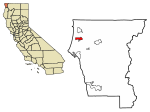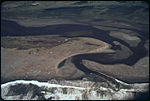Camp Lincoln (also known as Long's Camp, Fort Long, Lincoln's Fort, or Fort Lincoln), in Crescent City, California, was a United States military post. It was established June 13, 1862, by the men of Company G, 2nd Regiment, Infantry, California Volunteers to keep peace between the Tolowa tribe of Native Americans and the miners and settlers of northwestern California.
When the California Gold Rush began, people from all over the country ran to Gold Country to try to make their fortunes. Likewise in northwestern California, many men headed that way, leaving their wives, children, and homes. The Tolowa were being forcibly resettled in the region and were beginning to take their vengeance on those who stayed behind. Settlers petitioned the Army for protection, but their pleas were not well received by the Department of the Pacific, whose troops were already stretched thin from protecting stagecoach travelers.
However, the petitioners eventually got their wish, and Fort Ter-Waw was established. After that was destroyed by the Great Flood of 1862, the troops were moved to Camp Lincoln. In September 1862, the camp was moved six miles (10 km) north of the city to a more neutral position further away from the settlers.
During construction of the new location, tensions between the whites and the Tolowa rose even further. Many of the whites wanted the government to evict the Tolowa, but the government did no such action and they began to take matters into their own hands. Settlers burned crops and harassed the Tolowa, who were told to get out or be killed. Approximately 500 Tolowa decided to leave, and the remaining 1,500 stayed only because the Army promised to keep the peace.
Although no truce was reached, after the Civil War, the Army could not afford to staff many small posts, and the camp was abandoned in June 1869 and closed for good in May 1870.
Commanding officer's quarters and one barracks remained when the site was declared California Historical Landmark #545 in 1962.
 Continue reading on Wikipedia
Continue reading on Wikipedia 







